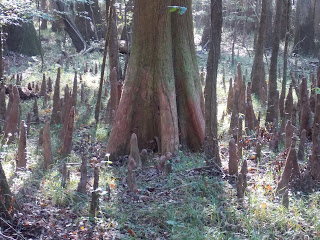After touring around Columbia, South Carolina on Wednesday, John and I were just not ready to head home. However, it was around 4 PM and most museums and even the zoo would be closing. Somehow John remembered reading about the only national park in South Carolina which was famous for its champion trees, trees that hold a record for size within their species. In the park there are at least 20 such champions here, including loblolly pines, hickories, and bald cypress. The park is about 20 miles southeast of downtown Columbia so we felt we could see it before it got dark. The visitor's center was within about 10 minutes of closing when we got there, but a park ranger took a few minutes to tell us about the park and encouraged us to take the self-guided boardwalk trail, located near the visitor's center. Armed with brochures explaining what we were about to see, we then headed out. We soon came to realize that it was dumb on our part to head out into a swampy area at dusk with no insect repellant! The mosquitoes sure enjoyed our walk, any time we slowed our pace they began munching on us!
The above picture may seem a bit weird, but it was the only way I could show the forest canopy. The forest canopy is said to be taller than any other deciduous forest on Earth. Giant sweetgum, tupelo, ash, elm, along with several species of oak and hickory, form the canopy. Along the boardwalk were also loblolly pines which, according to the information we had, stood from 150 to 167 feet high, some being 200 years old or more. We also saw a bald cypress which was 27 in. circumference. It was easy to readily identify the cypress trees because of their base which grows wide, to anchor the tree in the mud. Their "knees",which in the park can be up to 7 1/2 feet high, could be seen everywhere on the forest floor.
Speaking of mud, the Congaree floodplain floods about 10 times a year. Floodwaters deposit rich soils whose nutrients support the complex plant community of the park, including the giant trees. Speaking of diverse plants, along the boardwalk we noticed a variety of them. There is a paw paw grove, as well as areas of ferns and switch cane. South Carolina is called the Palmetto State, and the cabbage palm is the state tree. In the swamp area along the boardwalk is a patch of palmettos, the variety of which is a close relative of the cabbage palm. There are 22 different plant communities in the whole park.
Park information told us that we were walking "in the footprints of the Wateree and Congaree Indians, Francis"Swampfox" Marion, and Harry Hampton". Bootleggers also hung out here; off the trail in the distance we saw an iron box, in which they hid their still. While hiking we stopped at Lake Weston, it once was a bend in the Congaree River and is now an oxbow lake that is slowly filling with clay and humus. Here we saw several large turtles swimming at the shore line. Maybe they were hoping we would feed them!
Friday, September 28, 2012
Subscribe to:
Post Comments (Atom)




No comments:
Post a Comment